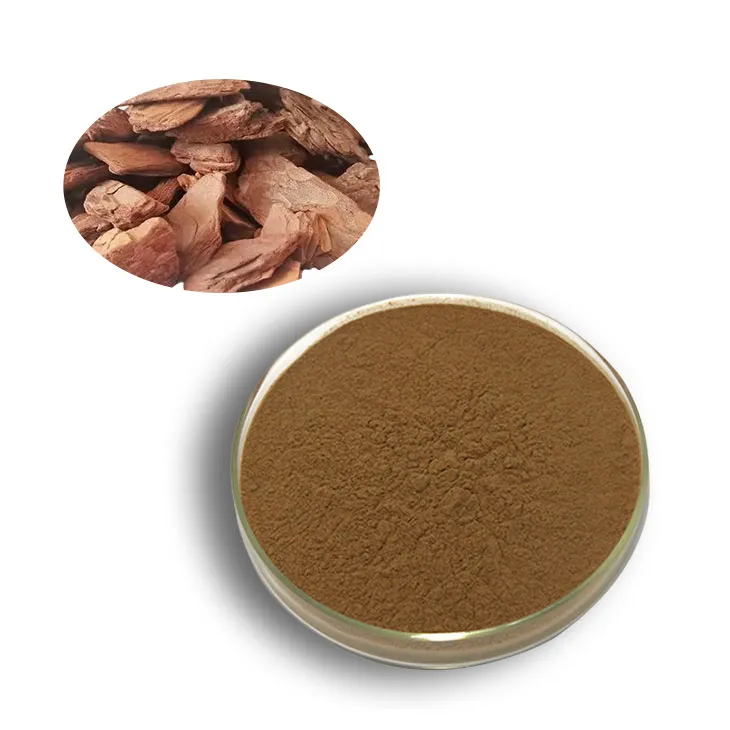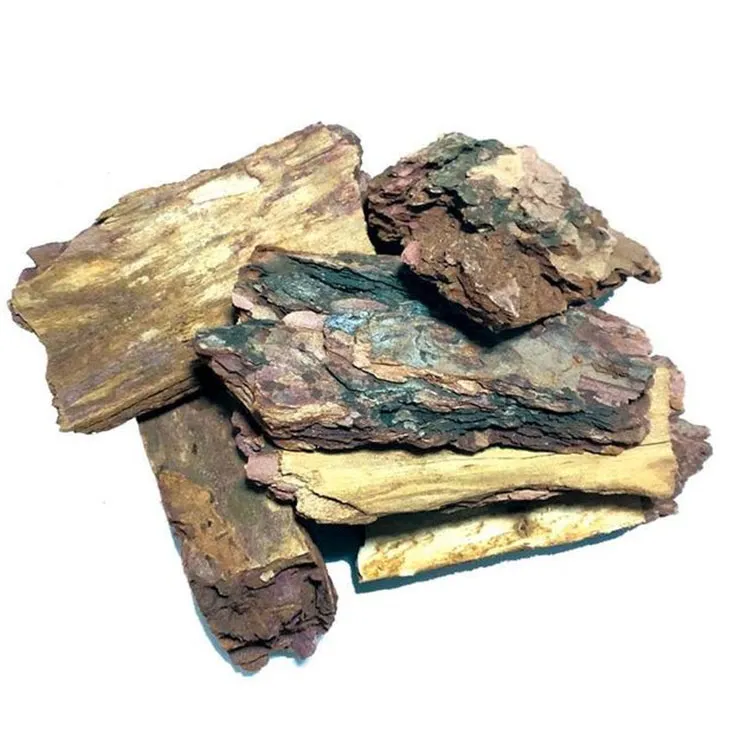- 0086-571-85302990
- sales@greenskybio.com
Active ingredients in pine bark extract powder.
2024-11-28

1. Introduction
Pine bark Extract Powder has been receiving increasing attention in recent years due to its numerous potential health benefits. This is mainly attributed to its various active ingredients. These active components play crucial roles in promoting human health, and their functions range from antioxidant protection to antimicrobial defense and the prevention of chronic diseases. In this article, we will explore the main active ingredients in Pine bark Extract Powder in detail.

2. Oligomeric Proanthocyanidins
2.1 Antioxidant Properties
Oligomeric proanthocyanidins are one of the most prominent active ingredients in Pine bark Extract Powder. They possess strong antioxidant capabilities. Antioxidants are substances that can prevent or slow down damage to cells caused by free radicals. Free radicals are unstable molecules that are generated during normal cellular metabolism as well as from external factors such as pollution, radiation, and smoking.
When free radicals accumulate in the body, they can cause oxidative stress. Oxidative stress is associated with a variety of health problems, including premature aging, neurodegenerative diseases, and cancer. Oligomeric proanthocyanidins act as powerful scavengers of free radicals. They can neutralize these harmful molecules before they can cause damage to cells. By doing so, they protect cells from premature aging and degeneration.
2.2 Mechanisms of Antioxidant Action
The antioxidant activity of oligomeric proanthocyanidins is based on their chemical structure. These molecules have multiple phenolic hydroxyl groups. These hydroxyl groups are able to donate electrons to free radicals, thereby neutralizing their reactivity. This electron - donating ability makes oligomeric proanthocyanidins highly effective in quenching a wide range of free radicals, including superoxide anions, hydroxyl radicals, and lipid peroxyl radicals.
Moreover, oligomeric proanthocyanidins can also chelate metal ions. Metal ions such as iron and copper can catalyze the formation of free radicals through Fenton and Haber - Weiss reactions. By chelating these metal ions, oligomeric proanthocyanidins can further reduce the production of free radicals in the body.

3. Terpene Acids
3.1 Antibacterial Properties
Terpene acids are another important class of active ingredients in pine bark extract powder. They are known for their antibacterial properties. Bacteria can cause a wide range of infections in the human body, from minor skin infections to more severe systemic infections. Terpene acids can inhibit the growth and reproduction of bacteria through multiple mechanisms.
One of the main mechanisms is by disrupting the bacterial cell membrane. The cell membrane is crucial for maintaining the integrity and function of bacteria. Terpene acids can interact with the lipid components of the bacterial cell membrane, causing changes in membrane permeability. This leads to the leakage of intracellular components and ultimately results in bacterial death.
Another mechanism is by interfering with bacterial metabolism. Terpene acids can affect the activity of key enzymes involved in bacterial metabolism, such as those involved in energy production and biosynthesis of essential macromolecules. By disrupting these metabolic processes, terpene acids can inhibit the growth and survival of bacteria.
3.2 Antiviral Properties
In addition to their antibacterial properties, terpene acids also possess antiviral properties. Viruses are obligate intracellular parasites that rely on host cells for their replication. Terpene acids can interfere with different stages of the viral life cycle.
For example, they can prevent the virus from attaching to host cells. Viral attachment to host cells is the first step in viral infection. By blocking this step, terpene acids can prevent the virus from entering the host cell and starting the replication process. Terpene acids can also inhibit viral replication once the virus has entered the host cell. They can affect the expression of viral genes or the activity of viral enzymes involved in replication, thereby reducing the production of new virus particles.

4. Stilbenes
4.1 Potential in Preventing Cardiovascular Diseases
Stilbenes are also found in pine bark extract powder and have been studied for their potential in preventing certain chronic diseases, especially cardiovascular diseases. Cardiovascular diseases are the leading cause of death worldwide. Stilbenes can act on multiple risk factors associated with cardiovascular diseases.
One of the ways stilbenes can benefit cardiovascular health is by improving blood lipid profiles. High levels of low - density lipoprotein (LDL) cholesterol and triglycerides are risk factors for cardiovascular diseases. Stilbenes can increase the levels of high - density lipoprotein (HDL) cholesterol, which is known as "good cholesterol," and reduce the levels of LDL cholesterol and triglycerides. This helps to maintain a healthy lipid balance in the blood.
Another mechanism is by reducing platelet aggregation. Platelets are small cell fragments in the blood that play a crucial role in blood clotting. However, excessive platelet aggregation can lead to the formation of blood clots in the blood vessels, which can cause heart attacks and strokes. Stilbenes can inhibit platelet aggregation, thereby reducing the risk of thrombosis and related cardiovascular events.
4.2 Other Potential Health Benefits
Besides their role in preventing cardiovascular diseases, stilbenes may also have other potential health benefits. Some studies have suggested that stilbenes may have anti - inflammatory properties. Inflammation is involved in many chronic diseases, including arthritis, diabetes, and certain cancers. By reducing inflammation, stilbenes may help to prevent or manage these diseases.
Stilbenes may also have potential anti - cancer properties. They can induce apoptosis (programmed cell death) in cancer cells, inhibit the growth and spread of tumors, and enhance the body's immune response against cancer. However, more research is needed to fully understand the anti - cancer mechanisms of stilbenes and their potential applications in cancer treatment.
5. Conclusion
In conclusion, pine bark extract powder contains several important active ingredients, including oligomeric proanthocyanidins, terpene acids, and stilbenes. These active components have diverse biological activities, such as antioxidant, antibacterial, antiviral, and the potential to prevent chronic diseases. The understanding of these active ingredients and their functions provides a scientific basis for the further development and application of pine bark extract powder in the fields of health care, medicine, and cosmetics.
However, it should be noted that while the potential health benefits of pine bark extract powder are promising, more research is still needed. This includes in - depth studies on the pharmacokinetics and bioavailability of these active ingredients, as well as large - scale clinical trials to confirm their safety and efficacy in humans. With further research, pine bark extract powder may become an important natural product with broad application prospects.
FAQ:
What are the main active ingredients in pine bark extract powder?
The main active ingredients in pine bark extract powder are oligomeric proanthocyanidins, terpene acids and stilbenes.
How do oligomeric proanthocyanidins in pine bark extract powder work?
Oligomeric proanthocyanidins in pine bark extract powder have strong antioxidant capabilities. They protect cells from premature aging and degeneration by neutralizing harmful free radicals.
What are the functions of terpene acids in pine bark extract powder?
Terpene acids in pine bark extract powder are known for their antibacterial and antiviral properties. They can help the body resist infections from bacteria and viruses.
How can stilbenes in pine bark extract powder contribute to health?
Stilbenes in pine bark extract powder have been studied for their potential in preventing certain chronic diseases, such as cardiovascular diseases, through mechanisms like improving blood lipid profiles and reducing platelet aggregation.
Are there any other benefits of pine bark extract powder?
Besides the functions of its active ingredients mentioned above, pine bark extract powder may also have other potential benefits which are still under research, such as anti - inflammatory effects and possible roles in skin health improvement.
Related literature
- The Active Compounds of Pine Bark Extract and Their Health - Promoting Effects"
- "Pine Bark Extract: A Review of its Active Ingredient Composition and Biological Activities"
- "Analysis of Active Ingredients in Pine Bark Extract Powder: Current Research and Future Perspectives"
- ▶ Hesperidin
- ▶ Citrus Bioflavonoids
- ▶ Plant Extract
- ▶ lycopene
- ▶ Diosmin
- ▶ Grape seed extract
- ▶ Sea buckthorn Juice Powder
- ▶ Fruit Juice Powder
- ▶ Hops Extract
- ▶ Artichoke Extract
- ▶ Mushroom extract
- ▶ Astaxanthin
- ▶ Green Tea Extract
- ▶ Curcumin
- ▶ Horse Chestnut Extract
- ▶ Other Product
- ▶ Boswellia Serrata Extract
- ▶ Resveratrol
- ▶ Marigold Extract
- ▶ Grape Leaf Extract
- ▶ New Product
- ▶ Aminolevulinic acid
- ▶ Cranberry Extract
- ▶ Red Yeast Rice
- ▶ Red Wine Extract
-
Soy Extract
2024-11-28
-
Marigold Extract
2024-11-28
-
Red Wine Extract
2024-11-28
-
Licorice Root Extract Powder
2024-11-28
-
Angelica sinensis extract
2024-11-28
-
Stevia Extract
2024-11-28
-
Ivy Extract
2024-11-28
-
Astaxanthin
2024-11-28
-
Grape Leaf Extract
2024-11-28
-
Bayberry Extract
2024-11-28





















